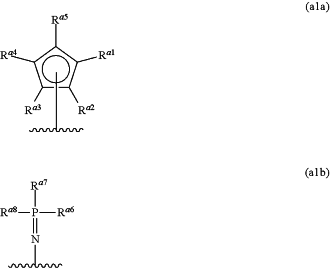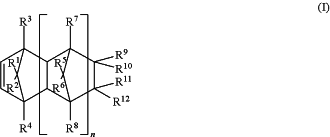| CPC C08F 232/04 (2013.01) [C08F 2/06 (2013.01); C08F 4/083 (2013.01); C08F 4/30 (2013.01); C08F 4/76 (2013.01); C08K 3/02 (2013.01); C08F 4/6592 (2013.01); C08F 232/06 (2013.01); C08F 2410/04 (2013.01); C08K 2003/026 (2013.01)] | 7 Claims |
|
1. A method for producing a cyclic olefin copolymer comprising a structural unit derived from a norbornene monomer and a structural unit derived from ethylene, the method comprising:
charging at least the norbornene monomer and the ethylene as monomers into a polymerization vessel, and
polymerizing the monomers in the polymerization vessel in presence of a metal-containing catalyst, the metal-containing catalyst having a structure in which a nitrogen atom is bonded to a transition metal of Group 4 of periodic table and an atom of Group 15 of periodic table,
wherein the metal-containing catalyst is a metal-containing compound represented by formula (a1):
 wherein in the formula (a1), M represents Ti, Zr or Hf, X represents an organic substituent having 1 to 20 carbon atoms and optionally containing a heteroatom, or a halogen atom, L1 represents a group represented by formula (ala) or (a1b):
 wherein in the formula (a1a), Ra1 to Ra5 are identical to or different from one another, and each independently represent a hydrogen atom, an organic substituent having 1 to 20 carbon atoms and optionally containing a heteroatom, or an inorganic substituent, two groups adjacent on the 5-membered ring of Ra1 to Ra5 are optionally bonded to each other to form a ring, wherein in the formula (a1b), Ra6 to Ra8 are identical to or different from one another, and each independently represent a hydrogen atom, an organic substituent having 1 to 20 carbon atoms
and optionally containing a heteroatom, or an inorganic substituent, two groups selected from Ra6 to Ra8 are optionally bonded to each other to form a ring,
wherein the organic substituent as Ra6 to Ra8 in the formula (a1b) is a group selected from an alkyl group having 1 to 20 carbon atoms, an alkoxy group having 1 to 20 carbon atoms, a cycloalkyl group having 3 to 20 carbon atoms, an aliphatic acyl group having 2 to 20 carbon atoms, a benzoyl group, an α-naphthylcarbonyl group, a β-naphthylcarbonyl group, an aromatic hydrocarbon group having 6 to 20 carbon atoms, an aralkyl group having 7 to 20 carbon atoms, a trialkylsilyl group having 3 to 20 carbon atoms, a monosubstituted amino group substituted with a hydrocarbon group having 1 to 20 carbon atoms, and a disubstituted amino group substituted with a hydrocarbon group having 1 to 20 carbon atoms, and
L2 represents the group represented by the formula (a1b)), and
wherein the norbornene monomer is one or more selected from a norbornene and a substituted norbornene represented by formula (I):
 wherein in the formula (I), R1 to R8 are identical to or different from one another, and are selected from the group consisting of a hydrogen atom, a halogen atom, and an alkyl group having 1 to 20 carbon atoms,
R9 to R12 are identical to or different from one another, and are selected from the group consisting of a hydrogen atom, a halogen atom, an alkyl group having 1 to 20 carbon atoms, a cycloalkyl group, an unsubstituted aromatic hydrocarbon group, and an aralkyl group,
R9 and R10 or R11 and R12 are not taken together to form a divalent hydrocarbon group,
R9 or R10 and R11 or R12 optionally form a ring with each other,
the ring that R9 or R10 and R11 or R12 form is not a ring having a double bond,
n represents 0 or a positive integer,
when n is two or more, R5 to R8 are identical to or different from each other in the respective repeating units, and
when n is 0, at least one of R1 to R4 and R9 to R12 is not a hydrogen atom.
|